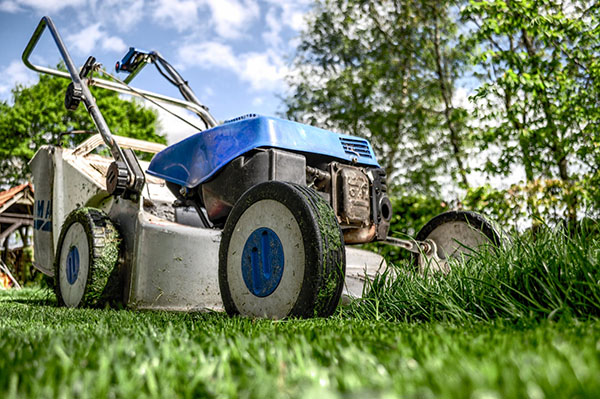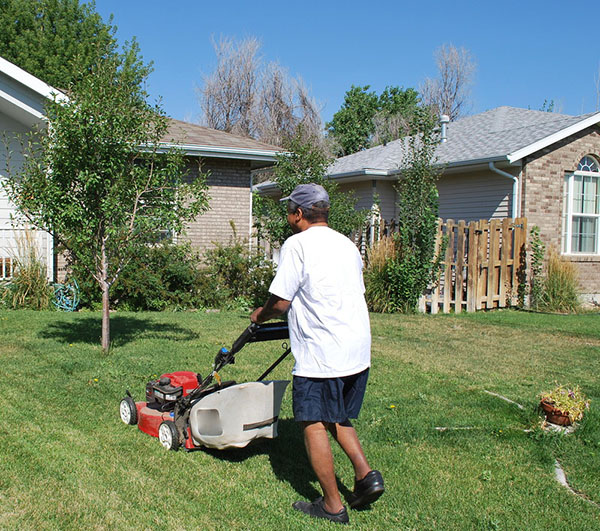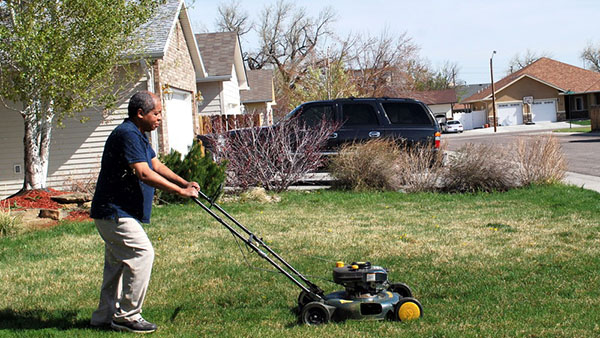By Lee Wallender
Contributing Writer
 Of all your outdoor tools, gasoline-powered lawn mowers suffer the greatest abuse. Subjected to season after season of chewing grass, ramming through weeds, hitting dirt and rocks, and sometimes being left out in the rain, these gas-powered machines take their share of beating.
Of all your outdoor tools, gasoline-powered lawn mowers suffer the greatest abuse. Subjected to season after season of chewing grass, ramming through weeds, hitting dirt and rocks, and sometimes being left out in the rain, these gas-powered machines take their share of beating.
Few homeowners properly maintain their lawn mowers, believing that these hardy machines will keep working forever. But, like any other tool, they will eventually break down. The great news for you is that lawn mowers are simple to diagnose and fairly easy to fix.
While mower technology has improved in the last few years, at their heart, they are still essentially the same thing: a gas-powered, small engine, which causes a metal blade to spin rapidly and cut grass.
The limited number of critical parts on mowers makes them within the realm of most homeowners’ repair skill-set. Most lawn mower problems are localized in three areas: spark plug, air filter, and fuel lines.
Spark Plugs: Maintenance and Replacement
Before you have a fire, you need a spark. Internal combustion machines are little more than small, contained fires that are harnessed to turn a drive shaft. And the part that creates the spark is the all-important spark plug.
The problem with spark plugs is that they can be either disconnected, loose, dirty, or defective.
Locating and Disconnecting the Spark Plug
You will find the spark plug located on the side of the engine, pointing sideways. The spark plug may not be immediately obvious, because it is hidden by a protective rubber cap, and the cap itself is attached to the spark plug wire. The cap forms a 90-degree angle to keep the wire fitted close to the engine.
Grasp the rubber cap and pull straight outward. This will release the cap and wire.
To remove the spark plug, use a spark plug wrench or deep socket (13/16 in. or 3/4 in.) attached to a ratchet wrench. Carefully turn the wrench counter-clockwise. Do not force it or you may end up breaking off the spark plug.
Top 4 Spark Plug Problems and Solutions
Disconnected Wire: The plug wire may be visibly disconnected with the wire entirely loose and dangling onto the lawn-mower deck. Or the wire may be only slightly disconnected but the rubber cover makes it look as though it is still attached. The solution is to firmly push the wire back onto the spark plug.
Loose Plug: Over time, the spark plug itself (not the plug wire) may have worked its way outward, losing contact with the engine. This is easily solved by gently tightening the plug clockwise with the spark plug wrench or ratchet wrench.
Dirty: Dirt, oil, grass, and other forms of gunk may have infiltrated the spark plug, compromising its ability to spark. Instead of discarding the plug, it is possible to clean minor deposits. After disconnecting the spark plug wire, use a rag to clean the area around the spark plug – before removing the plug. This helps avoid getting debris in the combustion chamber when you remove the plug. Unscrew the plug. With a wire brush and spark plug cleaner, gently brush away any minor deposits.
Defective: Spark plugs eventually become so corroded that they must be replaced. Manufacturers recommended replacement every 100 hours. If the deposits on the spark plug do not easily brush away or the plug’s porcelain is cracked, it is time to throw away the plug and replace it.
 Air Filter: Cleaning or Replacing
Air Filter: Cleaning or Replacing
Rarely will a dirty, clogged air filter cause your mower to immediately stop running. Rather, if you continue using a mower with a clogged filter, damage will occur to your mower’s engine slowly over time as the engine is unable to draw an adequate quantity of cooling air to run properly. Eventually, the mower will fail.
Symptoms of a dirty air filter which you will see immediately may include:
- Loss of Power: The mower loses its power and threatens to stall, especially in such problem areas as tall or wet grass.
- Excessive Fuel Consumption: As an example, if you were previously able to mow your lawn two full times before the tank runs out of gas, and now you consistently cannot finish that second mowing, your fuel consumption rate has increased. A clogged air filter may be one of the causes of this.
- Engine Running Rough: A sputtering, coughing engine that does not run smoothly cannot draw in enough air.
- Engine Will Not Turn Over: Rarely, in cases of extremely clogged filters, the engine will not turn over when you pull the cord or turn the key.
Cleaning the Filter
Locate the air filter on the side of the engine, typically behind a plastic or metal cover. Depending on your model, you will use either a screwdriver or wrench to loosen the screws or bolts holding the cover in place. Set the cover aside.
Pull the filter out. Examine the frame for cracks and the paper pleats for tears or holes. If you discover either condition, discard the filter as it cannot be cleaned.
Paper filters can be gently tapped to loosen the debris or cleaned with a shop vacuum. Foam filters can be washed in warm water with a mild detergent and left to air-dry.
Replacing the Filter
In most cases, it is better to replace than attempt to clean your air filter as air-inhibiting particles may be too small to shake or vacuum out.
To replace the filter, locate the filter cover as described above and remove it. Use the filter as a reference or consult your owner’s manual to find out what the correct filter for your mower is.
Filters usually snap into place by means of tabs. Clean the filter cover before replacing.
 Maintaining and Fixing the Fuel System
Maintaining and Fixing the Fuel System
Fuel must move freely through the lawn mower’s engine for it to run. Fuel that cannot reach the engine is a major reason that mowers do not start.
Begin by practicing safety: disconnect the spark plug as outlined above; wear latex or nitrile gloves to protect your hands from caustic gasoline; wait until the engine is completely cool; drain the fuel tank; and have a small empty container nearby to catch any spills.
Fuel Cap: Cleaning the Air Hole
One way that fuel movement is obstructed is when the fuel cap is clogged. Fuel caps have a small hole on top that allow vapor within the fuel tank to escape. When that pin hole is clogged with mud or grass, the fuel cannot move through the fuel line. Remove the cap and clear the hole with a shot of compressed air.
Fuel Line and Filter: Cleaning or Replacing
1. If your mower has a fuel valve that is located at the base of the fuel tank, turn this to the “Off” position.
2. Remove the metal housing the covers the engine to access the fuel tank.
3. Lift out the fuel tank.
4. With pliers, disconnect the fuel line by squeezing the spring-loaded clamps at each end of the line. The fuel line connects the carburetor to the fuel tank.
5. Examine the fuel line. If it is cracked – a common occurrence – replace it with a new one. If the fuel line is in good shape, use a can of compressed air to clear it.
6. Your mower’s fuel line may have an in-line filter. Replace the fuel filter as this is a sealed unit and cannot be cleaned out.
When your lawn mower will not start, in most cases, the spark plug, air filter, or fuel system is the problem. These are easy fixes that you can do yourself.
Sources:
- Value of Tune Ups – www.familyhandyman.com/automotive/lawn-mower-repair/tune-up-a-lawn-mower/view-all
- Spark Plugs – www.briggsandstratton.com/na/en_us/support/maintenance-how-to/browse/changing-spark-plugs.html
- Air Filter Symptoms – www.jackssmallengines.com/diy/dirty-air-filters-are-engine-killers/
- Finding and Changing Air Filter – Ehow Video, www.youtube.com/watch?v=hCQhjvNaUgc
- Lawn Mower Fuel Line Maintenance – www.hunker.com/13405172/how-to-clean-a-lawn-mower-engine-fuel-line
- Fuel Valves – www.tractorsupply.com/know-how_home-garden_outdoor-power-equipment_troubleshooting-lawnmower-fuel-lines
Lee Wallender began remodeling homes when he transformed a World War I-era farmhouse into a comfortable new home. He has been writing about home remodeling on About Home Renovations since 2006.
 Pride News Canada's Leader In African Canadian & Caribbean News, Views & Lifestyle
Pride News Canada's Leader In African Canadian & Caribbean News, Views & Lifestyle





